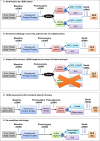Regulatory implications of ctDNA in immuno-oncology for solid tumors
- PMID: 36796877
- PMCID: PMC9936292
- DOI: 10.1136/jitc-2022-005344
Regulatory implications of ctDNA in immuno-oncology for solid tumors
Abstract
In the era of precision oncology, use of circulating tumor DNA (ctDNA) is emerging as a minimally invasive approach for the diagnosis and management of patients with cancer and as an enrichment tool in clinical trials. In recent years, the US Food and Drug Administration has approved multiple ctDNA-based companion diagnostic assays for the safe and effective use of targeted therapies and ctDNA-based assays are also being developed for use with immuno-oncology-based therapies. For early-stage solid tumor cancers, ctDNA may be particularly important to detect molecular residual disease (MRD) to support early implementation of adjuvant or escalated therapy to prevent development of metastatic disease. Clinical trials are also increasingly using ctDNA MRD for patient selection and stratification, with an ultimate goal of improving trial efficiency through use of an enriched patient population. Standardization and harmonization of ctDNA assays and methodologies, along with further clinical validation of ctDNA as a prognostic and predictive biomarker, are necessary before ctDNA may be considered as an efficacy-response biomarker to support regulatory decision making.
Keywords: Clinical Trials as Topic; Immunotherapy; Review.
© Author(s) (or their employer(s)) 2023. Re-use permitted under CC BY-NC. No commercial re-use. See rights and permissions. Published by BMJ.
Conflict of interest statement
Competing interests: None declared.
Figures

Similar articles
-
Bridging horizons beyond CIRCULATE-Japan: a new paradigm in molecular residual disease detection via whole genome sequencing-based circulating tumor DNA assay.Int J Clin Oncol. 2024 May;29(5):495-511. doi: 10.1007/s10147-024-02493-4. Epub 2024 Mar 29. Int J Clin Oncol. 2024. PMID: 38551727 Free PMC article. Review.
-
Impact of Circulating Tumor DNA-Based Detection of Molecular Residual Disease on the Conduct and Design of Clinical Trials for Solid Tumors.JCO Precis Oncol. 2022 Mar;6:e2100181. doi: 10.1200/PO.21.00181. JCO Precis Oncol. 2022. PMID: 35263168 Free PMC article. Review.
-
Circulating Tumor DNA in Precision Oncology and Its Applications in Colorectal Cancer.Int J Mol Sci. 2022 Apr 18;23(8):4441. doi: 10.3390/ijms23084441. Int J Mol Sci. 2022. PMID: 35457259 Free PMC article. Review.
-
Making the Rounds: Exploring the Role of Circulating Tumor DNA (ctDNA) in Non-Small Cell Lung Cancer.Int J Mol Sci. 2022 Aug 12;23(16):9006. doi: 10.3390/ijms23169006. Int J Mol Sci. 2022. PMID: 36012272 Free PMC article. Review.
-
Detecting Liquid Remnants of Solid Tumors: Circulating Tumor DNA Minimal Residual Disease.Cancer Discov. 2021 Dec 1;11(12):2968-2986. doi: 10.1158/2159-8290.CD-21-0634. Cancer Discov. 2021. PMID: 34785539 Free PMC article. Review.
Cited by
-
Extracellular vesicle-based liquid biopsy biomarkers and their application in precision immuno-oncology.Biomark Res. 2023 Nov 17;11(1):99. doi: 10.1186/s40364-023-00540-2. Biomark Res. 2023. PMID: 37978566 Free PMC article. Review.
-
A SITC vision: adapting clinical trials to accelerate drug development in cancer immunotherapy.J Immunother Cancer. 2025 Mar 22;13(3):e010760. doi: 10.1136/jitc-2024-010760. J Immunother Cancer. 2025. PMID: 40121030 Free PMC article.
-
Longitudinal genomic profiling using liquid biopsies in metastatic nonsquamous NSCLC following first line immunotherapy.NPJ Precis Oncol. 2025 Jan 8;9(1):5. doi: 10.1038/s41698-024-00797-2. NPJ Precis Oncol. 2025. PMID: 39779891 Free PMC article.
-
Liver Metastases and Immune Checkpoint Inhibitor Efficacy in Patients With Refractory Metastatic Colorectal Cancer: A Secondary Analysis of a Randomized Clinical Trial.JAMA Netw Open. 2023 Dec 1;6(12):e2346094. doi: 10.1001/jamanetworkopen.2023.46094. JAMA Netw Open. 2023. PMID: 38051531 Free PMC article. Clinical Trial.
-
Exploring the Clinical Value of Perioperative ctDNA-Based Detection of Molecular Residual Disease in Patients With Esophageal Squamous Cell Carcinoma.Thorac Cancer. 2025 Feb;16(4):e70017. doi: 10.1111/1759-7714.70017. Thorac Cancer. 2025. PMID: 39966084 Free PMC article.
References
-
- FDA draft guidance for industry: use of circulating tumor DNA for early stage solid tumor drug development. Available: https://www.fda.gov/media/158072/download [Accessed 31 May 2022].
Publication types
MeSH terms
Substances
LinkOut - more resources
Full Text Sources
Medical
